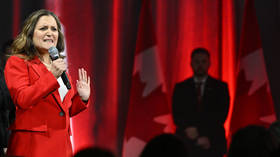NATO missile defense goes live in Europe, isolating Russia not the goal – Stoltenberg

NATO Secretary General Jens Stoltenberg announced that the alliance’s ballistic missile defense system in Europe is now operational. The system includes warships, long-range missile defense interceptors and radars placed across the territory controlled by the allied forces.
“Today we have decided to declare initial operational capability of the NATO ballistic missile defense system. This means that the US ships based in Spain, the radar in Turkey and the interceptor site in Romania are now able to work together under NATO command and NATO control," he explained.
Stoltenberg added that the shield is “entirely defensive" and "represents no threat to Russia's strategic nuclear deterrent.”
The system comes as NATO prepares to send a new deterrent to eastern Europe following Russia's 2014 annexation of Crimea. On Friday, the deterrent was approved by NATO leaders, who are now officially ready to send multinational troops to the Baltics and Poland to secure them from possible ‘Russian aggression.’
“These battalions will be robust and they will be multinational. They make clear that an attack on one ally will be considered an attack on the whole alliance,” Stoltenberg told reporters on the first day of the Warsaw Summit.
However, the Secretary General noted hat the measure does not mean thtat the allies want to isolate Russia: “We do not want a new Cold War, we do not want a new arms race and we do not seek new confrontation. As we strengthen our deterrents and our defense, we continue to seek a constructive dialogue with Russia."
"Russia is our biggest neighbor […] Russia cannot and should not be isolated,” the diplomat stressed, underlining the Alliance’s willingness to pursue a dialogue with Moscow, which is to be briefed on NATO’s decision at the Russia-NATO summit next week.
NATO leaders meet in Warsaw to show firm stance against “resurgent Russia,” but something doesn't add up. pic.twitter.com/EySUfqnTpH
— RT (@RT_com) July 8, 2016
German Chancellor Angela Merkel also noted that the allies did not address its increasing military presence along Russian borders, except for the planned four battalions, and said that both NATO and Russia are interested in mutual dialogue and coordination.
"There were no calls for an increase in the number of soldiers today. […] I think it is mutually beneficial, as it happens for example in Syria based on agreements between the United States and Russia, that NATO and Russia very closely coordinate their actions," Merkel told reporters.
Stoltenberg said the planned deployment in four member-states, namely Poland, Estonia, Latvia, and Lithuania, will consist of four rotational battalions totaling 3,000 to 4,000 troops. This number, he explained, is considered to be an “appropriate deterrent measure” based on military advice. Nearly all of the Alliance member-states will take part in supporting the battalions. However, the agreed upon number of troops is only a part of a larger defense system, Stoltenberg noted, while the timeline of the battalion presence in the region is open-ended and will last for as long as NATO deems it necessary.
Poor little NATO vs big bad Russia: a disinformation primer (Op-Edge) https://t.co/tiCsGhFCK9pic.twitter.com/huUKDJaZ0v
— RT (@RT_com) July 8, 2016
NATO member states also agreed upon a ‘balanced’ presence based on Romanian and Bulgarian land brigades in Southeast Europe and the Black Sea region. This matter is to be further discussed at the defense ministerial session in October, Stoltenberg said.
"Today we agreed to increase NATO presence in the Black Sea region […] through setting up a Romania-Bulgaria multinational battalion. We already increased NATO’s presence in the region [through] air policing missions [and] missile defense systems and AWAC planes in Turkey. We also decided to ask our military planners […] how we can increase our presence [not only] on land, but in the air and at sea," Stoltenberg said.
Furthermore, Stoltenberg said that NATO member states have officially recognized cyberspace as a new domain for military and defense operations.
Unity, but not unanimity? NATO split on countering Russia amid Warsaw summit https://t.co/zDBxIu4ZRk#WSEF16pic.twitter.com/FmOcpPnTlI
— RT (@RT_com) July 8, 2016
“Today we also recognized cyberspace as a new operational domain, joining land, air and sea. This means better protection of our networks and our missions and operations with more focus on cyber training and cyber planning," the Secretary General clarified, adding that the allies plan to increase their own cyber security and exchange information between the member-states.
The summit of the leaders of the 27-member NATO alliance, including Barack Obama, Angela Merkel and others, kicked off in the Polish capital on Friday, focusing on boosting security in the eastern part of the bloc. The summit is to last two days, ending on Saturday.













